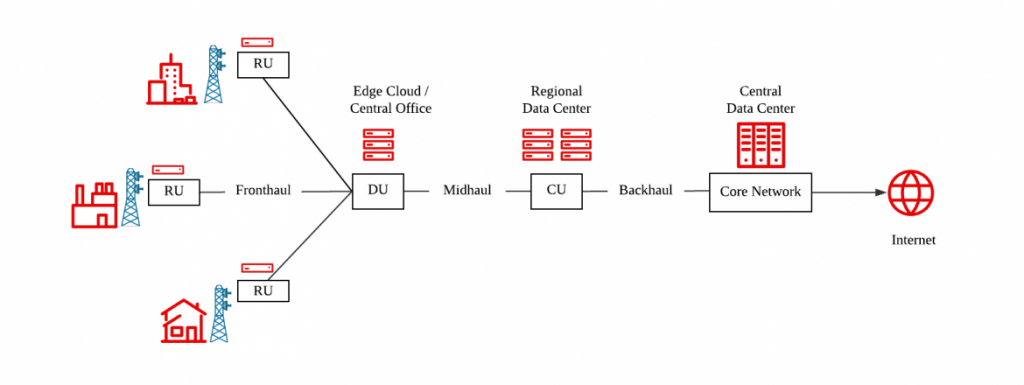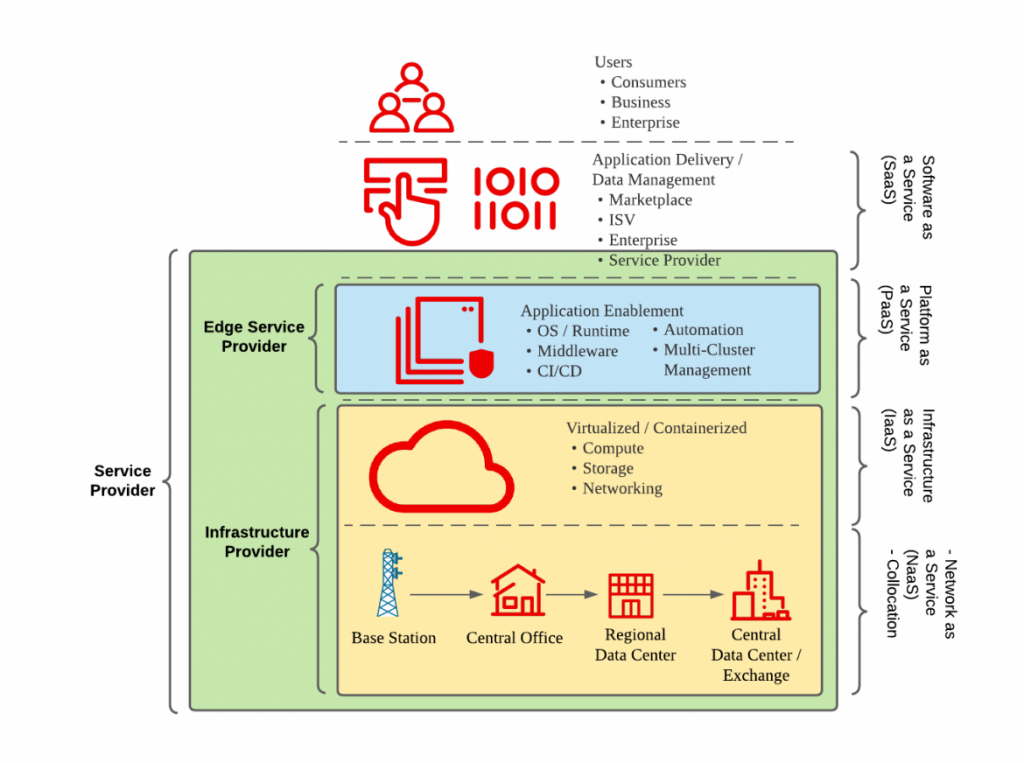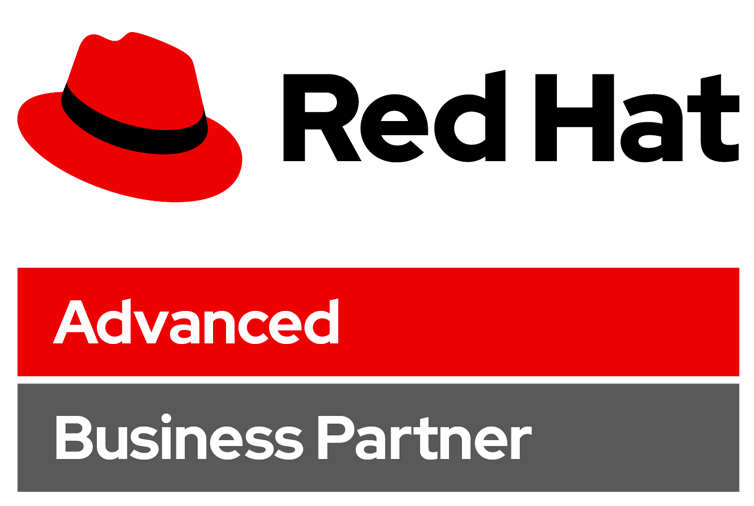Edge Computing to help Scale 5G
The 5G mobile network is the latest global wireless standard developed by 3GPP. While 4G networks provide connectivity to most current cell phones, 5G can enable connectivity for an expanded set of devices, from machines to vehicles. In this post, we’ll share some advantages of 5G, provide an overview of edge computing and look at some potential use cases.
What challenges can 5G address?
5G has been designed to meet many challenging requirements, including:
- Significantly higher throughput (up to 20 Gbps peak data rates based on IMT-2020 requirements) in mobile broadband, such as 4K videos streaming or virtual reality (VR).
- Ultra-low latency (less than 1 millisecond) for real-time communications, such as surveillance drone maneuvering.
- Massive network capacity, with plans to exceed the number of connected devices per unit area by over 100x compared with 4G/LTE technologies.
- A more uniform user experience and more users, i.e. higher reliability in crowded areas such as stadium and sports events.
- Improved energy efficiency, including reducing power consumption and the delivery of cellular Internet of Things (IoT) devices that can last for more than 10 years.
- The new 5G core network follows a Service-Based Architecture (SBA), which allows for the adoption of cloud-native technologies and open source software into telecom networks and brings in more collaboration, innovation, and openness.
Based on this vision, the International Telecommunication Union (ITU) has envisioned several use cases and defined them under three main categories in the “IMT Vision for 2020 and beyond” (the categories are shown in figure 1). Most of us might focus on the enhanced Mobile Broadband (eMBB) use case, but the biggest disruption of 5G will be by massive Machine Type Communications (mMTC) and Ultra-Reliable and Low Latency Communications (URLLC) type use cases such as autonomous vehicles, smart city, and industrial automation.
Use cases for 5G

What is edge computing?
The full picture of 5G can only be understood with edge computing.
Edge computing is computing that takes place at or near the physical location of either the user or the source of the data, which results in lower latency and saves bandwidth.
Effectively, edge computing is a concept that enables services to be hosted close to the service consumers (e.g., subscribers, machines, and devices). Being closer provides benefits, including significantly reducing end-to-end latency, decreasing load and saving cost on the backhaul transport network and enhancing data privacy (i.e., private 5G use case). The edge computing paradigm is the only way to realize the latest 5G URLLC use case, and it also addresses many challenging mobile network issues in 5G technologies.
The Emerging Edge Computing Use Cases of 5G
Many new 5G use cases, such as virtual and augmented reality (VR/AR), IoT, Industrial IoT, autonomous cars and drones, real-time multiplayer gaming, and most recently the deployment of open Radio Access Networks, depend on edge computing (open RAN).
Mobile Broadband & Open RAN.
Mobile broadband is the most popular 3G/4G use case, and it is also the first 5G commercial use case for the general public. Through the 5G New Radio (a.k.a. NR), the 5G eMBB mobile broadband service offers 10 to 100 times faster broadband speeds than 4G, particularly in higher frequency bands (i.e., mmWave spectrum allocated above 24GHz) and denser small cell sites.
To evolve this massive radio network toward an open, intelligent, virtualized (or containerized), and fully interoperable RAN, open RAN standards and deployment have been piloted by several mobile operators. Open RAN is possibly the first prevailing edge computing use case in 5G mobile network.
As the following sample open RAN architecture describes, the modern 5G radio access network has been split and de-coupled into the Central Unit (CU), Distributed Unit (DU), and Radio Unit (RU) through open interfaces like fronthaul, midhaul, and backhaul.
This architecture disaggregates RAN hardware (HW) and software (SW) through the vendor-neutral and general-purpose processor platforms (i.e., Intel x86-64 or ARM). It also allows multi-vendor interoperability and enables a diverse ecosystem for mobile operators to choose best-of-breed options for their 5G deployments.
 Sample open RAN architecture
Sample open RAN architecture
To date, we have seen several successful open RAN CU/DU deployments on top of the edge cloud since 2020. This underlying edge cloud is based on commercial-off-the-shelf (COTS) servers with hardware acceleration components like FPGA, eASIC, or GPU. Besides, even the RU in the remote cell sites has gradually shifted to a white box hardware built on an open and disaggregated architecture.
These edge and far edge deployments typically run on a massive scale. For example, there are about 400,000 cell sites in the United States, so it is quite common to see thousands of compute nodes in each deployment. As the telco industry continues its shift from proprietary to open based technology, open RAN is expected to be quite popular in the near future.
In recent customer projects, Red Hat saw several open RAN implementations on top of Red Hat edge cloud solutions, including a Virtual Network Functions (VNF) based implementation on Red Hat OpenStack Platform and OpenStack Distributed Compute Node (DCN, for centralizing the control plane and optimizing the cost in edge sites), as well as a Containerized Network Functions (CNF) based implementation on Red Hat OpenShift.
To meet the grueling real-time performance requirements like L1 and low L2 functions in DU, even the best operating systems, such as standard Linux and Windows platforms, cannot guarantee a mandatory and consistent performance.
A real-time operating system with a preemptive scheduling algorithm is necessary in order to achieve deterministic performance. Red Hat Enterprise Linux Real-Time (RHEL-RT) has been proven to be capable of carrier-grade performance and reliability in commercially operational mobile vRAN networks.
Low Latency Applications and Edge Cloud Platform
For the incoming low latency and real-time use cases, such as VR/AR, autonomous and connected vehicles, drone control, telesurgery and medical robotic instruments, and real-time multiplayer online gaming, the edge computing paradigm is the most effective way to ensure the low latency and also minimize the backhaul bandwidth and cost.
As mobile operators can’t build all the use cases themselves, they will need to attract partners and developers to build an optimized ecosystem on top of their edge cloud. Independent software vendors (ISV) and enterprise developers demand a platform that can help abstract the network complexity, including making use of the mobile network capabilities (e.g., user location, SIM-based authentication, prepaid/postpaid payment mechanism, etc.) in a more secure way.
It is similar to what AWS, Azure, and Google have provided in the public cloud. Without the edge cloud platform, mobile operators will fall back to the “dumb pipe” utility model and continue suffering from the declined average cellular data price.
 Roles operators can play in the edge cloud value chain
Roles operators can play in the edge cloud value chain
To meet the needs of various edge computing scenarios, an edge computing solution should support hybrid workloads of virtual machines (VMs), containers, bare-metal nodes running network functions, and Artificial Intelligence and Machine Learning (AI/ML) workloads in microservices architectures. This solution needs to have operational simplicity by automating bare-metal provisioning, application onboarding, tenants and workload isolation, software-defined networking and storage, as well as management and orchestration.
Red Hat considers edge cloud and computing as an integral part of its open hybrid cloud strategy, and works to provide a consistent experience for everyone from the application developer to the infrastructure operations team. This consistency should be end-to-end, from edge devices, network, up to the centralized datacenter to maximize potential. Hybrid cloud strategy and approach provide sanity to what would otherwise be chaos across a technology ecosystem.
Outlook on the future of edge computing
When 5G development has been evolving into Phase 2 (3GPP Release 16) and Phase 3 (3GPP Release 17), the focus of 5G has been moving to mMTC and URLLC use cases. As a result, more and more vertical use cases (e.g., Industry 4.0) have been discussed and addressed.
Although 5G is relatively new, edge computing may play a significant role in the 5G ecosystem. Edge computing and processing will be used to cache, analyze, and filter local content. The edge cloud can also act as an intermediary, and forward data only when needed to the core network so it can optimize the backhaul bandwidth requirement.
This decentralized approach improves resilience, provides real-time interaction, enables local content and privacy, and delivers a superior user experience. It also enables mobile operators to support more use cases and reach customers faster. Finally, it leads to differentiation and the creation of new revenue streams for mobile operators.
As 5G is still quickly evolving, it is difficult to foresee all possible developments and requirements.
Because of this, it is nearly impossible to have a single vendor that can provide a complete edge computing solution. Instead, an evolving edge computing solution will most likely be formed from multiple components by multiple vendors.
That is exactly what open source is here for. When choosing open source solutions, edge technologies work across a wide ecosystem and communities–as there is no proprietary technology stack–and removes vendor lock-in.
Red Hat knows that the future edge computing platform has to be innovative, hybrid, and open, and we’re actively working in the open source communities that may power the next era of edge cloud computing technology.
It continues to draw on the power of upstream technologies while evolving our enterprise open source portfolio of products in automation, cloud infrastructure, automation, containers and Kubernetes, applications development and middleware.
Red Hat is extending open hybrid cloud to the edge with Red Hat OpenShift Red Hat Advanced Cluster Management for Kubernetes, RHEL, and Red Hat OpenShift.









